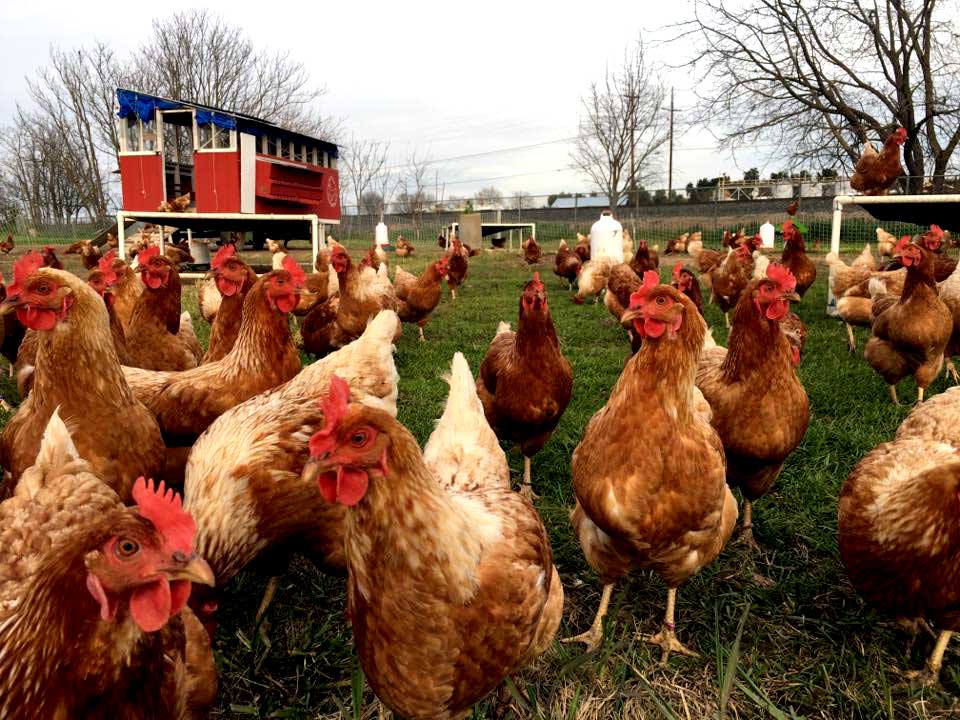Organic farms are based on diversity, from wide variation in plant species composition above ground to the billions of microbes that make up the soil microbiome. Ensuring diversity in the pastures we manage fosters resilience and productivity, and is a natural application of our fundamental organic, agrarian values. Producers who combine perennial pasture, cover crops in rotation on annual fields, and good grazing management with high species diversity will see benefits to soil health and increased revenue due to reduced inputs and higher productivity. This is particularly important for organic farmers, who apply nature’s design to make animals and pastures more resilient and productive.
“The presence of multiple species of large herbivores is the typical condition of grassland and savanna ecosystems,” says John Walker, a range ecologist who wrote on the subject more than two decades ago (Multispecies grazing: The ecological advantage, by John Walker, 1994). Early in my career I was taught to plant one or two species of pasture forages and graze them continuously with a single livestock species. This practice is still evident if you drive around the countryside and look critically at pastures. Most often you see a closely grazed landscape peppered with the mature stalks from less-palatable plants. Cattle and sheep that graze continuously easily select the newest growth and cause selection pressure that results in the eventual demise of the best forages. This picture, however, can change.
There has long been an interest in grazing multiple species together, either sequentially or at the same time. More producers are adding diversity to their farms, not only by adding diverse pasture mixes and cover crops, but with multiple species of livestock. There are some very good reasons for doing this. A well-managed farm with abundant diversity is generally healthier, has greater carrying capacity, fewer weed problems, and higher net income.
Multispecies grazing takes full advantage of biological diversity. Those farmers who work hard to increase pasture-plant diversity will also see an even greater advantage by adding diversity of livestock to the mix. In fact, these ideas go hand in hand. Multispecies grazing works best, and excels, when a multitude of forage species make up the pasture composition. As vegetation of pastures becomes more diverse, multispecies grazing tends to improve composition and utilization.
Multispecies Grazing Increases Carrying Capacity
This management practice “may be one of the most biologically and economically viable systems available to producers, especially on landscapes that support heterogeneous plant communities” (Managing livestock using animal behavior: Mixed-species stocking and flerds, by Dean Anderson, E. L. Fredrickson, and Rick Estell. Animal, 2012). Studies have shown that when you add sheep to a cattle herd, you get 20 to 25 percent greater productivity and carrying capacity over cattle alone, and 8 to 9 percent greater productivity and carrying capacity over sheep alone (Walker, 1994).
Ecological Resiliency and Better Pasture Health
Grazing, when controlled and matched to the pasture resource, is known to increase pasture health. Diversity is key here, and just as diversity of plant species leads to greater soil health, having diverse animal species on the landscape adds a multiplier effect. Proper grazing increases soil aggregation, enhancing soil structure and allowing for better water-holding capacity and nutrient exchange. Grazing also contributes soil organic matter and rumen microbes to the soil that help to increase biodiversity, buffer soil temperature, escalate nutrient cycling, and minimize soil compaction and disturbance.
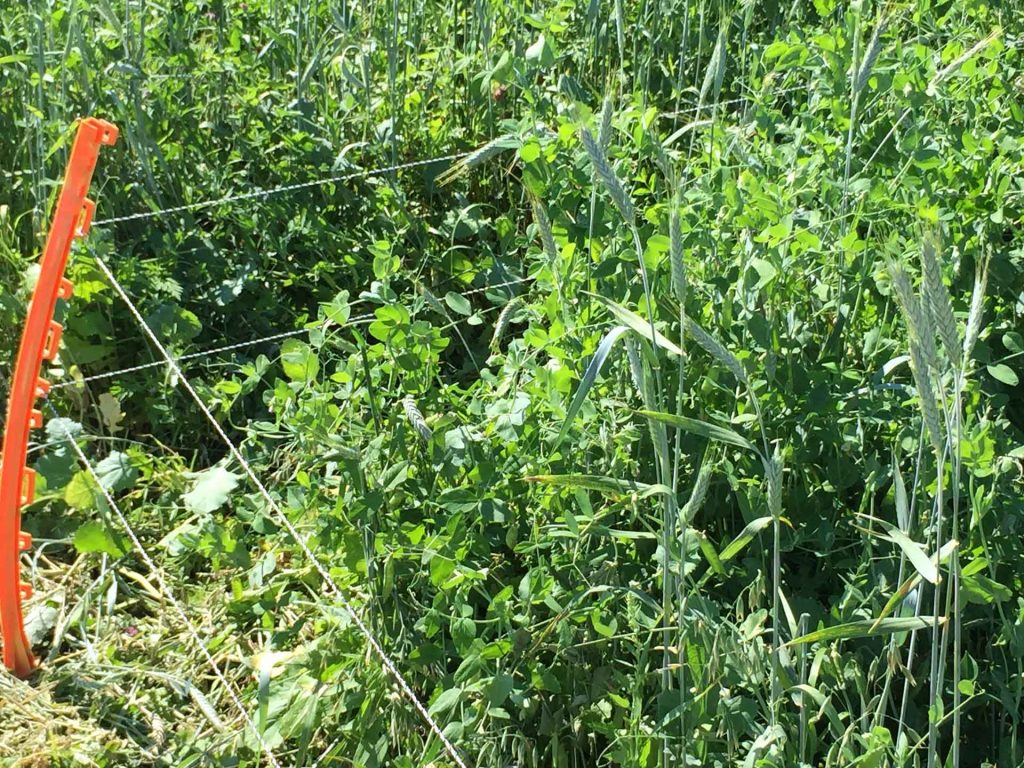
Because different animal species have different grazing habits and select various forages and combinations of forages, pastures that are grazed with multiple species have more uniform defoliation. Defecation patterns affect nutrient cycling, and whereas cattle prefer not to graze around their dung, sheep generally do not have any bias about foraging near cow patties. Better forage utilization and uniformity of grazing contributes greatly to forage quality and resiliency by keeping forage growth constant; resetting the plants to the same stage of growth with each grazing event and preventing weedy or unpalatable plants from taking over.
Vegetation Management
Pastures that have infestations of weeds or brush can be grazed with species appropriate to the plants present. This reduces the ability of any one species to dominate the landscape. Grazing managers must understand the growth habits of weeds and desirable plant species and know what animals graze them, in order to target-graze the weeds, and allow palatable plants enough rest to recover. This is especially important where invasive plants are involved. One species may eat what another will reject and, by using the correct livestock, managers can suppress and reduce a weed problem in a cost-effective and ecologically responsible way. With knowledge of plant response to grazing and timing of grazing events, grazing managers can alter the landscape to a healthy, diverse, quality pasture.
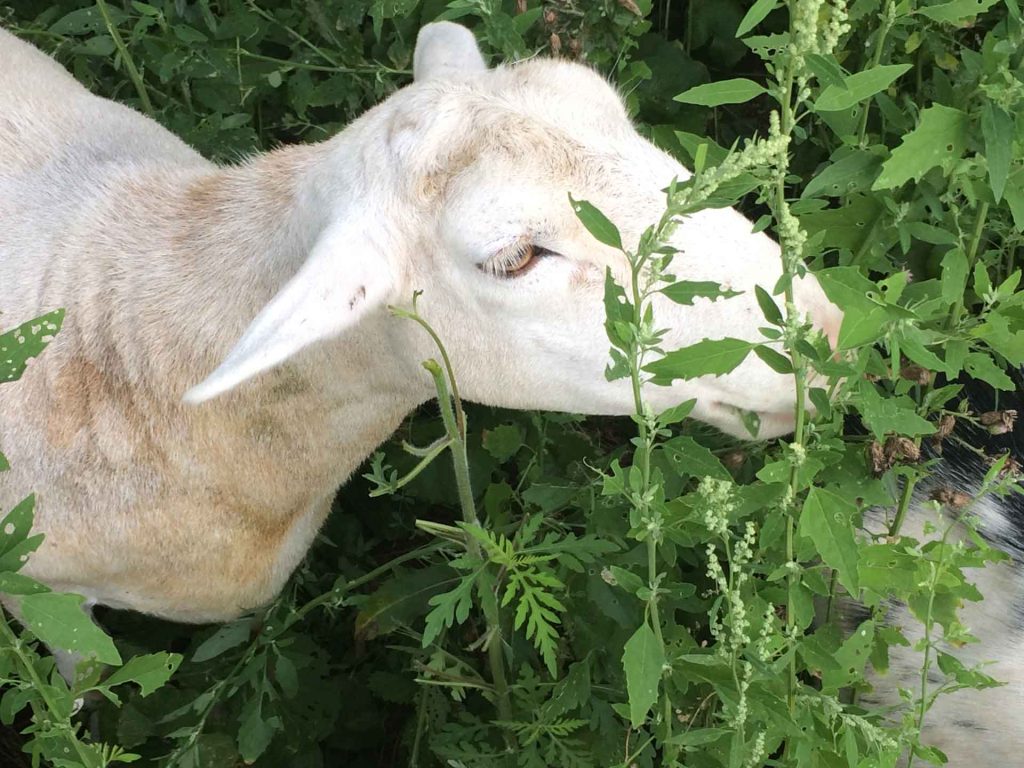
Parasite Control
One of the biggest benefits of multispecies grazing is its effect on parasite management. Cattle will consume parasite larvae such as the Barber Pole Worm (a sheep and goat parasite) and because this worm is incompatible with cattle, the worms will die. The same thing happens when small ruminants consume parasites that are indigenous to cattle. Because of parasite larval incompatibility between species, cattle can be grazed after or with small ruminants to reduce the incidence of larval infection.
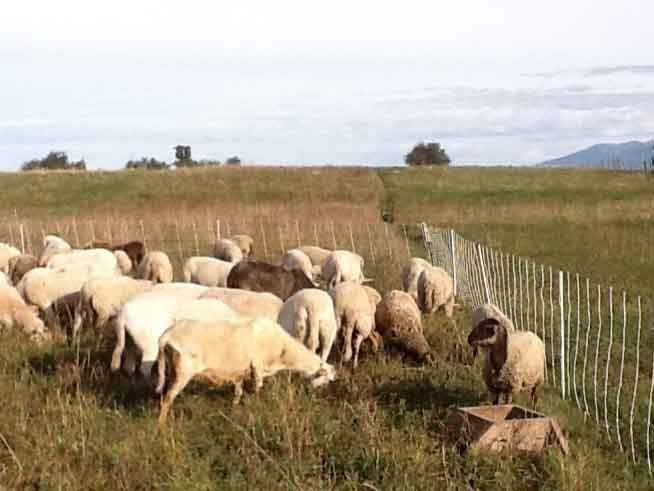
Managing forage height is key in controlling internal parasites. As long as you keep grazing the top leaves of the sward, and move the animals before they graze too low, you can significantly reduce infection. Also, give the paddocks a nice long recovery period. This is not only good for pasture health and resiliency, it also allows parasites to die off in the pasture before they can be consumed by a grazing animal.
Animals can deal with a certain amount of parasitism, and you’ll never be able to completely eradicate internal parasites from your herd or flock. However, an integrated management system with combined livestock species can certainly make a dent in parasite populations. The key here is maintaining a healthy herd or flock and fostering natural immunity through good nutrition, clean, fresh water, and pasture access. One of the best methods for controlling parasitism, in addition to observation and targeted treatment, is culling and selection for resistance when breeding and acquiring new animals.
Diversity of Enterprises/Income
Grazing two or more species together has been shown to increase animal production (Walker, 1994). As was mentioned above, the carrying capacity is increased when two or more livestock species are grazed on the same pasture. This results in higher productivity and increased cash flow from the greater production of added enterprises.
Predator Control
Due to their size, small livestock like sheep and goats are targets for predators such as coyotes, mountain lions, wolves, bears, and even neighborhood dogs. The first line of defense should be strong, adequate fencing. But, depending on your location and predator pressure, fencing may not be enough to protect your livestock. Sheep and goats can be better protected by a combination of adequate fencing, bonding to larger livestock species (such as cattle, donkeys, or llamas), and using guardian dogs.
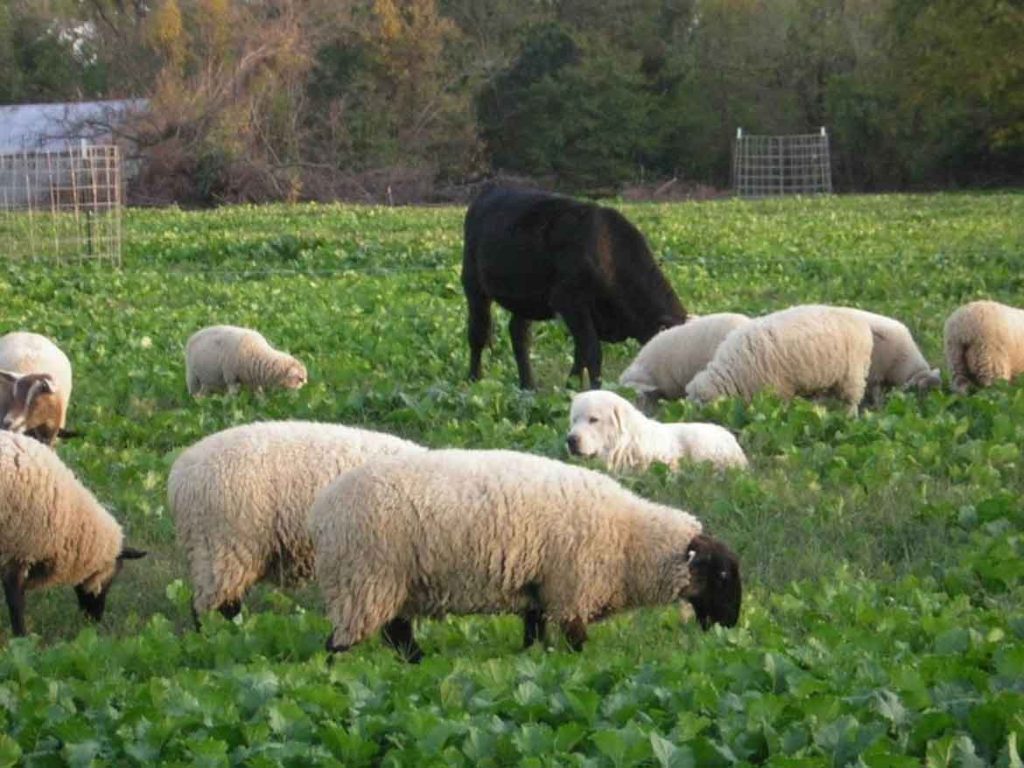
When small ruminants are bonded to cattle to form one herd/flock (or, ‘flerd’), they tend to remain together in a group that provides safety from predators and takes less time to manage. Bonding species together imparts many more benefits as well. For instance, cattle fencing can work very well for sheep when they are bonded to cattle. Grazing distribution is enhanced as sheep and goats tend to spread out more evenly as they graze with cattle, compared with flocks that are not bonded.
Key Considerations for Implementing Multispecies Grazing
Fencing and Working Facilities
Fencing is probably the most critical and challenging component of multispecies grazing from a practical standpoint, and is a crucial question given the size and behavioral differences between livestock species. Your fencing should serve multiple purposes. Certainly, you’re going to want to keep your animals off the highway or out of the neighbor’s garden. But you’ll also be using your fencing as a tool to control grazing in specific areas for specific animals.
Your perimeter fencing should be strong and permanent. Be sure to pay attention to gates and areas where terrain changes, or where fallen trees or stumps are near the fenceline. Goats have an uncanny ability to squeeze between gates and posts that otherwise work well for cattle or sheep.
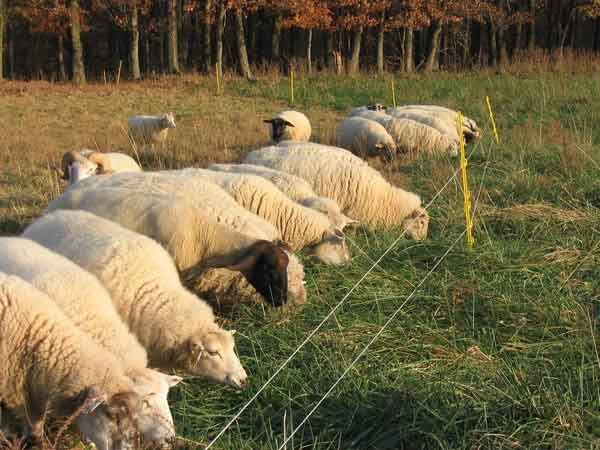
Next, you’ll be thinking about how to deal with pasture and paddock subdivisions. This is the working part of your fence system that will place the animals just where you want them and will help you manage grazing for the benefit of the livestock and the pasture. There are so many options out there, and the first thing to think about is what you have on hand. Is it appropriate for multiple species? Polywire or polytape can work for cattle, sheep, or goats, especially if you use three strands.
If you want to use polywire or polytape, train animals to the wire by placing them in a pen with a hot polywire and just expose them to it for about a week, so they can get used to the new idea. These materials are portable and allow you to adjust paddock size as resources and herd size demand. For small paddocks, electrified netting works great and is easy to move.
For larger paddocks, some producers have suggested that woven wire with two electric wires, offset and at the top, works best for sheep and goats. A really hot wire fence is sometimes is the only way to deter some predators. A 30- to 50-joule charger is not unwarranted, because you want to instill fear of the fence in any predator that encounters it. Dave Scott, an Appropriate Technology Transfer for Rural Areas (ATTRA) specialist and sheep rancher in Montana, recommends that producers with high predator pressure buy a charger that is twice the joule rating of what they initially think they need.
Working Facilities and Shelter
A well-designed handling system considers the welfare and behavioral tendencies of the animals, ease of movement, efficient and safe operation by handlers, and the overall image of the livestock industry as seen by the consumer.
A livestock handling facility should be constructed to accommodate a particular class of livestock. Because of the size differences between cattle and small ruminants, they cannot both use the same chutes and restraining systems. However, if you have a combined herd of cattle and sheep or goats, a system could be built to take care of both species if you have a single trap or holding pen that would provide access to two separate chute and restraint systems; one for the cattle, and one for the small ruminants.
Livestock require very little in the way of shelter, but do need to be protected from wind chill, especially when it’s cold and raining. Animals use energy to maintain their body heat, and extremes in temperature can cause stress, notably for young animals. For cattle, windbreaks or a grove of trees or woods can often provide what they need to get out of the weather. And, although sheep and goats don’t require much shelter, either, it’s important to note that goats typically don’t like rain. Lambing and kidding can and should, in most cases, occur on pasture, where the animals have access to fresh air and flock behavior, but young lambs and kids are very sensitive to wet and cold. For the safety of young animals, especially in winter and foul weather, animals can be brought into a barn prior to parturition and kept there for several days after lambing or kidding, until the young ones gain their footing and are ready for pasture.
Mineral Supplementation
Grazing different species together can cause some logistical problems that go beyond fencing and working facilities and require producers to think about new ways of accommodating the needs of different animals. One of these issues is mineral supplementation. Cattle mineral should not be fed to sheep due to sheep’s lower tolerance of copper.
Stocking-Rate Decisions
The goal in determining a stocking rate is to find a combination of two or more livestock species that will produce more total gain, while maintaining the integrity of the pasture ecology and improving the pasture composition. There’s no hard-and-fast rule for determining a stocking rate, but as with single-species systems, it should be based on empirical observation of forage production and plant composition.
Your stocking rate will likely vary from year to year, and even from season to season, and will change depending on temperature, rainfall, pasture composition, animal growth rates, and many other factors. Also, remember that sheep and goat herds grow more quickly than cattle herds. Within a few months you can easily go from 50 sheep to 150 sheep, and this will place added pressure on your pastures. Be sure to take this increased herd size into account when you are planning your grazing.
Stocking rate is dependent on the available forage resources of the landscape and the kind of management employed to ensure pastures are well rested. If you have adequate, diverse forages, maintain a short grazing period, move animals regularly, and provide adequate pasture rest, you can increase your stocking rate. Remember: implement, observe, adapt.
If you are just starting out with multispecies grazing, it might be best to stock a little conservatively. This will allow you to observe and adapt. Greg Brann, a multispecies grazier in Tennessee and a retired Natural Resources Conservation Service (NRCS) professional, suggests matching the livestock stocking ratio to the vegetation that livestock prefer. He’s found that a 1:1 or 1:2 ratio of sheep to cattle works well as a starting point.
Pigs can be an excellent addition to a multispecies grazing operation. They work well following cattle and sheep, and can help renovate old, worn-out pastures. Maintaining adequate ground cover is a challenge for pastured swine producers, and, if not managed, pigs will strip a pasture bare, which has negative impacts on soil and water quality. To ensure pasture productivity, provide a varied pasture mix of diverse legumes, forbs, and grasses. Stock the pigs appropriately with around 15 to 20 growing pigs or four to seven sows per acre and rotate! Make sure there is adequate time for pasture regrowth.
Multispecies grazing is all about matching animals to the appropriate landscape. It’s about having the right fencing and working facilities for the species you’re working with. It’s about managing parasites and predation and ensuring proper mineral supplementation. Finally, it’s about determining an accurate stocking rate to use the pasture resource efficiently and sustainably. With these principles in mind, combining multiple species on pasture can be successful, profitable, and fun.
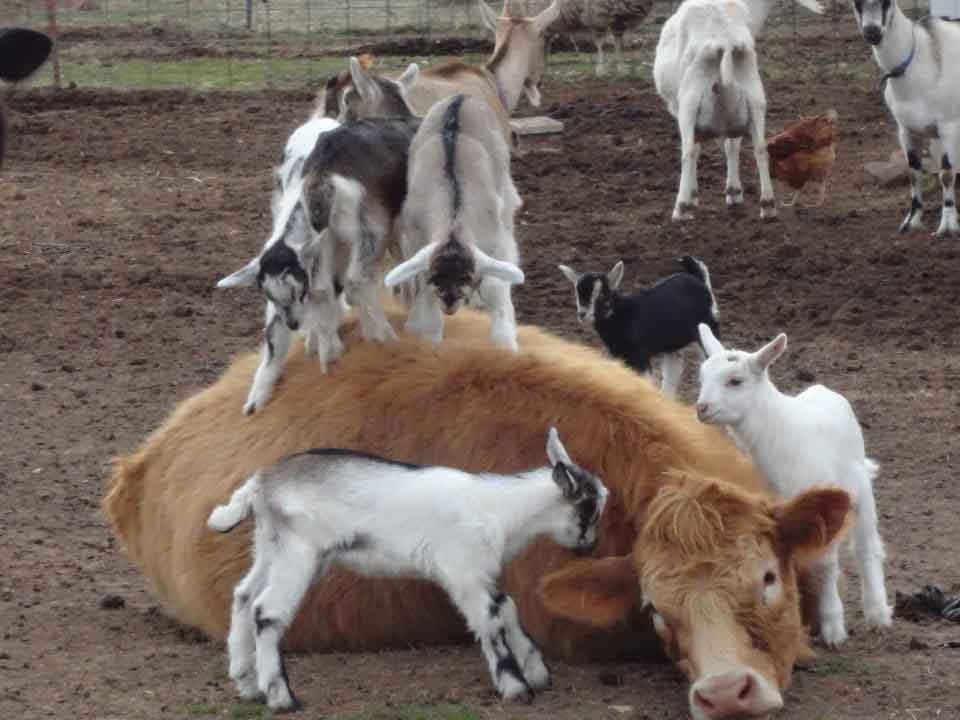
Resources
ATTRA has developed some in-depth resources and training programs to help you plan, implement, and monitor your managed grazing system:
ATTRA’s Managed Grazing Tutorial
https://tutorials.ncat.org/
This course was designed to help producers manage toward productivity and resilience. Topics include inventory, infrastructure, managing the mature stand, intensifying grazing, stockpiling, fertility and soil health, and monitoring.
Grazier’s One-Stop Resource Packet
https://attra.ncat.org/attra-pub/summaries/summary.php?pub=587
Includes useful planning tools for managed grazing, including a Clip and Weigh Forage Yield Calculator, Grazier’s Calculator for matching forage to animal demand, a Monitoring Checklist, and a Grazier’s Math tipsheet with useful formulas.
This article has been adapted from the ATTRA publication Multispecies Grazing: A Primer on Diversity (2018), by Lee Rinehart. Download the publication at https://attra.ncat.org/attra-pub-summaries/?pub=244
Lee Rinehart has been writing and educating on sustainable agriculture for over 20 years. A graduate of Texas A&M University and an Agriculture Specialist for NCAT’s ATTRA Sustainable Agriculture program, his work focuses on agronomy, livestock, and grazing. Lee can be reached at 479-587-3474 or lee@ncat.org.



